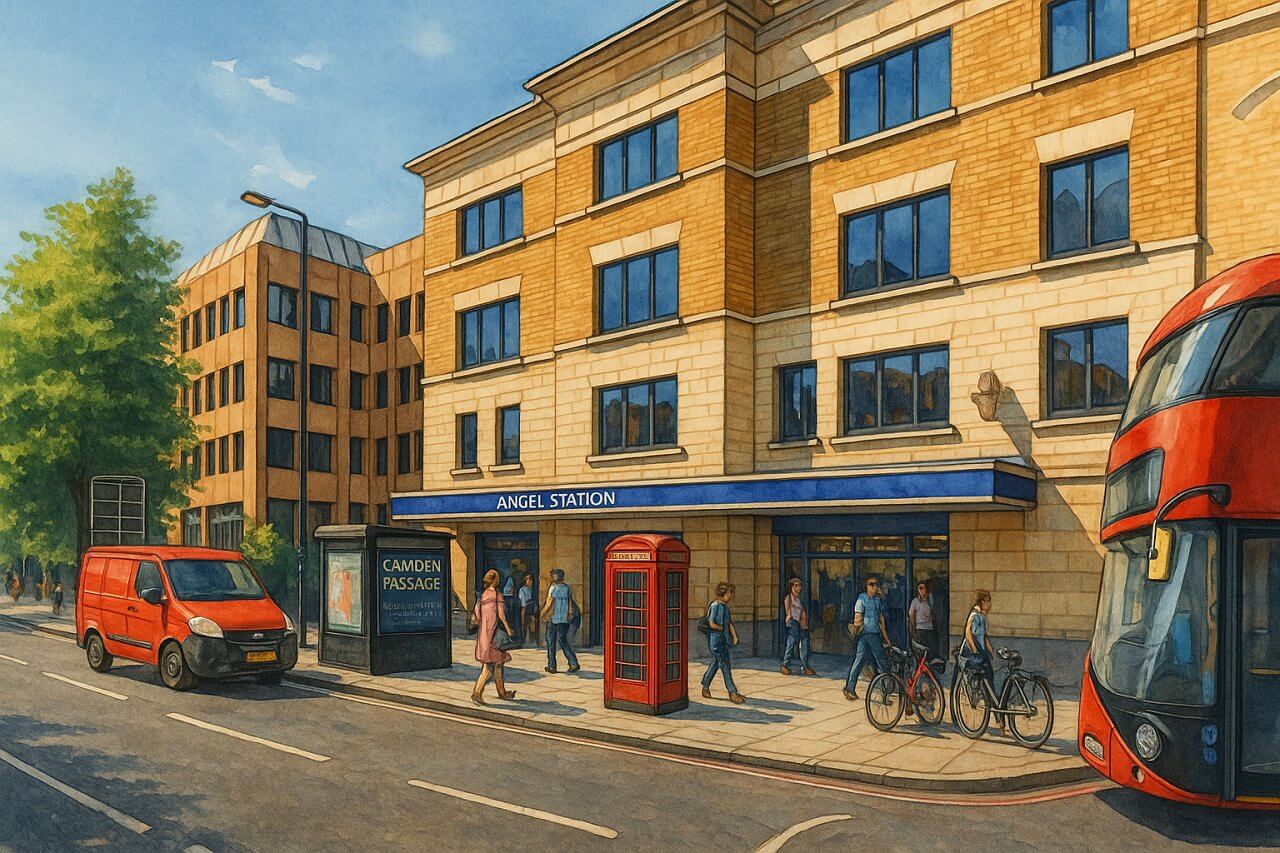
Angel Station, London
Angel Station is a London Underground station located in the London Borough of Islington, situated in north-central London. It sits on the Northern line and provides a convenient gateway to the popular Angel area, known for its mix of shopping, dining, and cultural attractions.
Location and Distance from Charing Cross
Angel Station is located on Islington High Street (A1), near the junction with Pentonville Road. By road, it is approximately 2.2 miles (3.5 km) north of Charing Cross, the traditional centre of London. A drive between the two points typically takes about 15 to 20 minutes, depending on traffic conditions.
From Angel to Charing Cross by Tube
Travelling from Angel Station to Charing Cross Station on the London Underground is both straightforward and affordable. Since both stations are located in Zone 1, the journey qualifies as a short central London trip. Using a contactless card or Oyster card, the adult fare is £2.80 during peak hours and £2.70 during off-peak hours. Peak times are weekdays from 06:30 to 09:30 and from 16:00 to 19:00. At all other times—including weekends and public holidays—the off-peak fare applies. The most direct route is via the Northern line southbound, which runs directly from Angel to Charing Cross with no changes required. Paper tickets are available but cost significantly more, around £6.70 for a single journey, making Oyster or contactless the most cost-effective choice.
History of Angel Station
Angel Station was originally opened on 17 November 1901 as part of the City & South London Railway (C&SLR), which was later absorbed into what is now the Northern line. At its inception, the station featured a single central platform located in a narrow tunnel, which quickly became insufficient due to rising passenger numbers and safety concerns.
In the early 1990s, major reconstruction work was undertaken. The old narrow platform was closed, and a completely new station layout with two separate tunnels and platforms was introduced. The new, modernised Angel Station was officially reopened in 1992.
How the Station Got Its Name
The station takes its name from the area known as Angel, which itself is named after a historic inn called The Angel. This coaching inn, dating back to the 17th century, stood on the corner of Islington High Street and Pentonville Road. The name was applied to the local area and eventually to the Underground station when it opened in 19011.
Rail Services at Angel Station
Angel Station is served exclusively by the London Underground. It is located on the Bank branch of the Northern line, which runs between Morden in the south and Edgware or High Barnet in the north. Angel does not offer services from the Overground or National Rail networks.
Northern Line Services
On the Northern line, the preceding station when travelling southbound is Old Street, and the next station northbound is King's Cross St. Pancras. This makes Angel a well-connected point for anyone heading into central London or transferring to national and international train services via King's Cross or St. Pancras International.
Fun Fact: Longest Escalator on the Underground
One of the most fascinating features of Angel Station is that it boasts the longest escalator on the London Underground. The escalator is an impressive 60 metres (197 feet) long, with a vertical rise of 27.5 metres (90 feet). It contains 318 steps and was installed as part of the station’s 1990s redevelopment2.
This record-holding escalator has made Angel Station a small point of interest even for those not using the Underground, and it has even featured in various media over the years due to its dramatic visual appeal.
Nearby Attractions
Angel Station serves one of London’s most vibrant neighbourhoods. Just a short walk from the station, visitors can explore:
- Regent’s Canal – a peaceful waterside walk offering cafes and scenic views.
- Sadler’s Wells Theatre – a world-renowned venue for contemporary dance and performance.
- Camden Passage – a charming lane filled with vintage shops and antique markets.
- Islington Green – a small but pleasant green space ideal for a quiet moment amid urban life.
Accessibility and Station Layout
Angel Station is not currently step-free, which may be a concern for those with limited mobility. Access from street to platform requires the use of escalators and stairs. The 1990s redesign dramatically improved safety and passenger flow, including wider platforms and better lighting.
Quick Facts
- Station Name: Angel
- Opened: 17 November 1901
- Rebuilt: Early 1990s (modern layout opened in 1992)
- Line: Northern line (Bank branch)
- Borough: London Borough of Islington
- Distance from Charing Cross: Approx. 2.2 miles by road
- Adjacent Stations: Old Street (southbound), King's Cross St. Pancras (northbound)
- Services: London Underground only (no Overground or National Rail)
- Fun Fact: Longest escalator on the London Underground (60m, 318 steps)
- Name Origin: Named after the 17th-century Angel Inn
- Accessibility: No step-free access
- Nearby Attractions: Sadler’s Wells Theatre, Regent’s Canal, Camden Passage
References
Angel Station is  on the Map of London Underground
on the Map of London Underground

Painting of Angel Station, London (View image in full size)